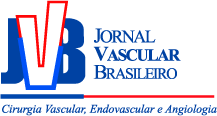Endolaser venoso: estudo série de casos
Venous endolaser: a case series report
Karina Silvestri Bueno; Daiane Tais Schlindwein Albernaz; Luiz Fernando Lima Albernaz; Fernanda Rita Machado Zignani
Resumo
Palavras-chave
Abstract
Keywords
References
Darwood RJ, Gough MJ. Endovenous Laser treatment for uncomplicated varicose veins. Phlebology.. 2009;24 Suppl 1:50-61.
Rasmussen RH, Lawaetz M, Bjoern L, Vennits B, Blemings A, Eklof B. Randomized clinical trial comparing endovenous laser ablation, radiofrequency ablation, foam sclerotherapy and surgical stripping for great saphenous varicose veins. Br J Surg.. 2011;98:1079-87.
Jung IM, Min SI, Heo SC, Ahn YJ, Hwang KT, Chung JK. Combined endovenous laser treatment and ambulatory phebectomy for the treatment of saphenous vein incompetence. Phlebology.. 2008;23:172-7.
Pannier F, Rabe E, Rits J, Kadiss A, Maurins U. Endovenous laser ablation of great saphenous veins using a 1470 nm diode laser and the radial fibre-follow-up after six months. Phlebology.. 2011;26:35‑9.
Van den Bos RR, Kockaert MA, Neumann HA, Nijsten T. Technical review of endovenous laser therapy for varicose veins. Eur J Vasc Endovasc Surg.. 2008;35:88-95.
Schwarz T, Von Hodenberg E, Furtwängler C, Rastan A, Zeller T, Neumann FJ. Endovenous laser ablation of varicose veins with the 1470-nm diode laser. J Vasc Surgery.. 2010;51:1474-8.
Pannier F, Rabe E, Maurins U. 1470 nm diode laser for endovenous ablation (EVLA) of incompetent saphenous veins - a prospective randomized pilot study comparing warm and cold tumescence anaesthesia. Vasa.. 2010;39:249-55.
Doganci S, Demirkilic U. Comparison of 980 nm laser and bare-tip fibre with 1470 nm laser and radial fibre in the treatment of great saphenous vein varicosities: a prospective randomised clinical trial. Eur J Vasc Endovasc Surg.. 2010;40:254-9.
Vuylsteke M, De Bo T, Dompe G, Di Crisci D, Abbad C, Mordon S. Endovenous laser treatment: is there a clinical difference between using a 1500 nm and a 980 nm diode laser? A multicenter randomised clinical trial. Int Angiol.. 2011;30:327-34.
Soracco JE, D'Ambola JO. New wavelength for the endovascular treatment of lower limb venous insufficiency. Int Angiol.. 2009;28:281-8.
Luccas GC, Menezes FH, Barel EV, Medeiros AAFM. Varizes dos membros inferiores: Tratamento. Cirurgia Vascular. :1530-50.



